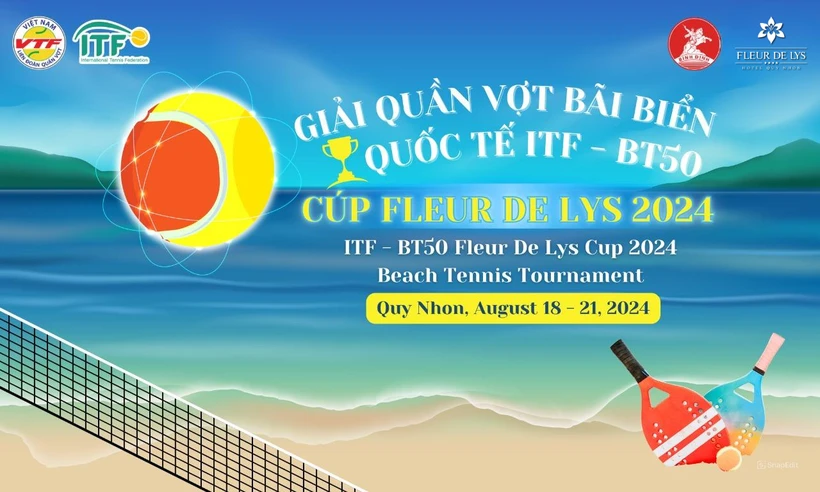 |
| The poster of the event (Source: binhdinh.gov.vn) |
It is the first time Vietnam has hosted the two international beach tennis tournaments, which offer total cash prizes of 4,000 USD each.
With the venue being the Xuan Dieu Beach in Binh Dinh’s Quy Nhon city, the competitions will feature 30 athletes from Japan, Thailand, the Philippines, Slovakia and Latvia, and Vietnam, among others. They are set to take part in the men's and women's double categories.
According to the Vietnam Tennis Federation, these first international events mark the turning point for local and national beach tennis, expected to be an exciting watch for supporters and visitors.
Beach tennis is a game combining tennis and volleyball and is played on sand. It has been played in over 50 countries and by more than half a million people since its first days in 1970. The sport is particularly popular in Italy, Brazil and Spain where they have the greatest numbers of beach tennis players in the world.
Vietnam aims for 1.5 billion USD target from livestock exports
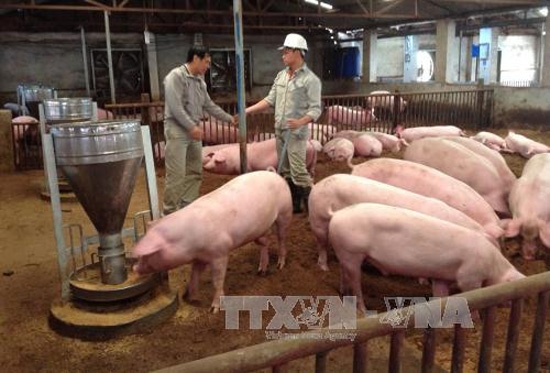 |
| A pig farm in Soc Son district, Hanoi (Photo: VNA) |
Vietnam is ramping up efforts to increase its livestock product exports, targeting a value of 1-1.5 billion USD by 2025, said the Vietnam News Agency.
With a robust start to the year, exports hit 240 million USD in the first half, marking a 3.8% annual increase, as reported by the Ministry of Agriculture and Rural Development. Processed meat products are leading the pack, with fresh, chilled, and frozen pork following closely behind.
Vietnam's processed chicken meat has already made inroads into Japan, Hong Kong (China), five countries within the Eurasian Economic Union, and Mongolia.
The country has secured significant wins, including export licenses for dairy and bird's nest products to China. Now, the Department of Animal Health (DAH) is actively pursuing expanded market access for these and other livestock products, and engaging in negotiations with the Republic of Korea, Singapore, the EU, the UK, and the Middle East.
DAH Director Nguyen Van Long revealed ongoing talks with the Republic of Korea's Ministry of Food and Drug Safety to finalise food safety conditions for poultry products.
Major industry players like Masan, C.P. Vietnam, Koyu & Unitek, Japfa, De Heus and GreenFeed are also investing heavily in disease-free zones and state-of-the-art processing facilities.
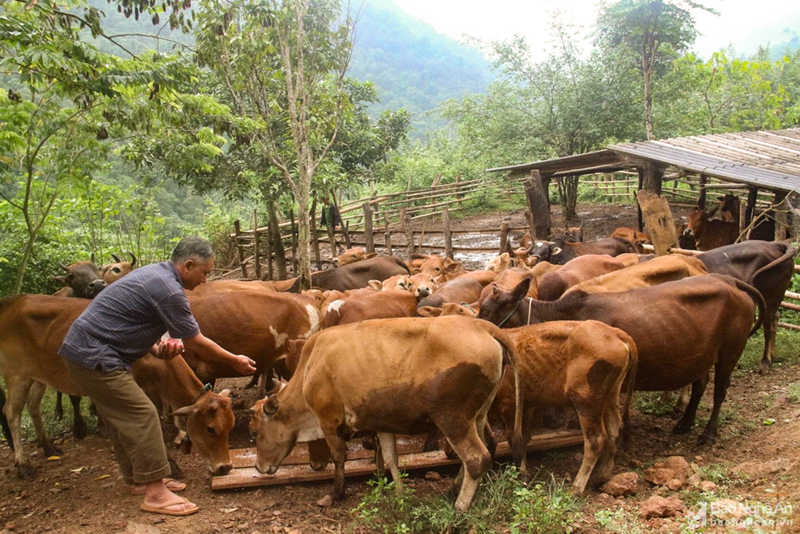 |
| Vietnam aims for 1.5 billion USD target from livestock exports (Photo: kinhtenongthon.vn) |
Deputy Minister of Agriculture and Rural Development Phung Duc Tien said the agriculture sector aims for comprehensive, efficient, and sustainable livestock development that adapts to climate change through industrialisation and modernisation. This approach focuses on integrating value chains, circular economy principles to enhance added value and ensure biosecurity, disease control, and food safety.
Diversifying export markets and tapping into new opportunities, such as the Halal market, is crucial for boosting overall exports and specifically enhancing the export of livestock products, Tien added.
Malaysia-Vietnam festival showcases culinary delights, business opportunities
The Malaysia-Vietnam Trade, Tourism & Investment Promotion and Cultural Food Festival concluded its four-day run in Kuala Lumpur on August 18, drawing hundreds of eager visitors exploring the rich cultural and business ties between the two nations, according to the Vietnam News Agency.
Co-hosted by the Vietnam Malaysia Business Association (VMBIZ) and Malaysian event management powerhouse DANG Production Bhd, the event was a vibrant mix of food, tourism and trade.
Over 40 food booths, primarily run by long-established Vietnamese enterprises in Kuala Lumpur like Vinh City, Viet-Thai-Cambodia Mart, and Mini Nguyen Café, tempted visitors with a diverse range of traditional dishes from all three regions of Vietnam. Popular dishes of the northern region like pho, fried spring rolls, and banh mi (Vietnamese sandwich) were on offer, alongside specialties of the central region such as fresh summer rolls, banh xeo (crispy pancake) and banh bot loc (rice dumpling cake). The southern region's cuisine was represented by beef sausage and broken rice.
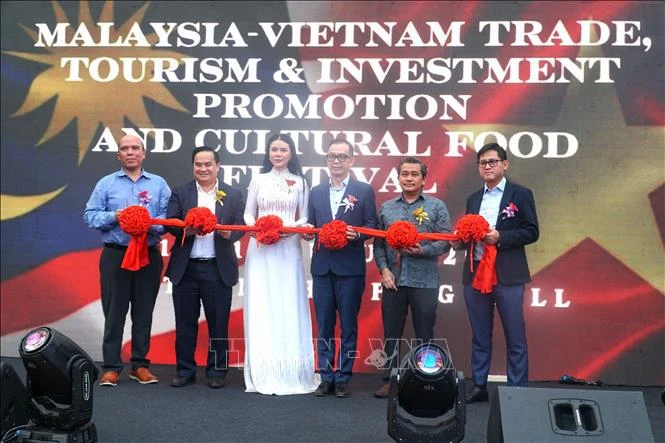 |
| At the ribbon-cutting ceremony (Photo: VNA) |
Among the trade exhibitors, Suca AgriFood and Joho Botanical stood out as the sole representatives from Vietnam. Hailing from Dak Lak province and Ho Chi Minh City, they showcased premium natural herbal beauty products, including macadamia nuts, cashew nuts, black soybeans, skincare, hair care, and body oils, all meeting requirements of Muslim consumers.
The festival also highlighted stunning beaches of Da Nang and Hoi An through Muslim-friendly tour packages, featuring hotels with prayer facilities and Halal-certified food. Meanwhile, mosque tour packages in Malaysia also piqued the interest of young Vietnamese travelers.
As of August 18 afternoon, the organising board recorded over 1,000 visitors to the event.
This achievement was made possible with support from the Malaysian Ministry of Tourism, Arts, and Culture, the ASEAN Retail-Chains and Franchise Federation (ARFF), the Business Association of Overseas Vietnamese, and the Vietnamese Embassy in Malaysia.
Smart checkpoints to be piloted at Vietnam-China border gate pair
Deputy Prime Minister Le Thanh Long has signed to issue Decision 865/QD-TTg approving a pilot project on building smart border checkpoints at a specialised freight transport routes through the areas of Border Markers No.1119 – 1120 and No.1088/2 – 1089 of the Huu Nghi (Vietnam) – Youyi Guan (China) International Border Gate Pair, the Vietnam News Agency reported.
The project is carried out in two phases from Q3 of 2024 to the end of Q3 of 2029, with the building of infrastructure from Q3/2024 to the end of Q2/2026, and pilot implementation from Q3/2026.
Its capital is sourced from the state budget, in association with capital of approved programmes and projects, and mobilised from socialisation sources and other legal capital as regulated.
The project aims to build the northern mountainous province of Lang Son, where the Huu Nghi border gate is located, into one of the key centres and hubs for import-export, trade and tourism activities in the northeastern region; and an important gateway for goods trade between ASEAN countries and the Chinese market and other nations.
It also looks to develop Huu Nghi into a model border gate, the most advanced road border gate in the Association of Southeast Asian Nations (ASEAN), based on high technology applications, with a modern road transport system connecting to seaports and airports; while establishing the largest road-based commercial centre in Vietnam for trade with ASEAN countries and China, and vice versa.
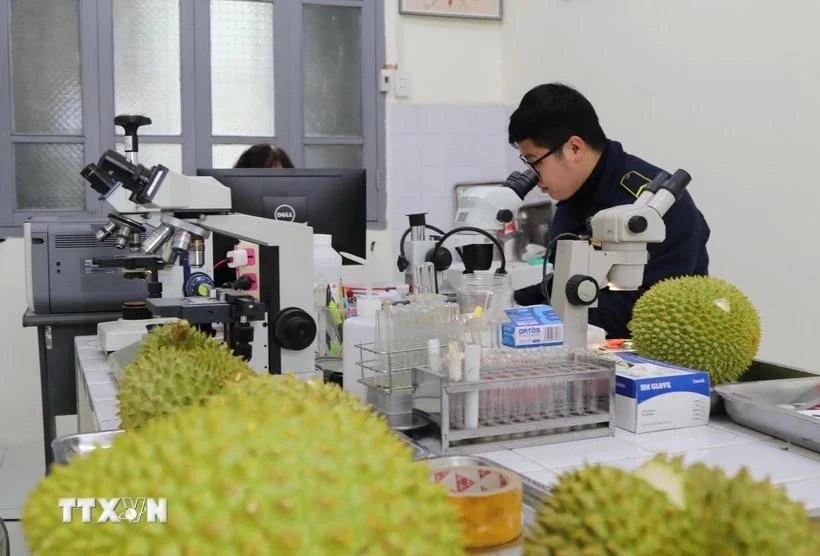 |
| Plant Quarantine staffs at Huu Nghi border gate check exported agricultural products. (Photo: VNA) |
Accordingly, the smart checkpoints will apply new methods for handling imports and exports based on the use of modern science and technology in the procedures for import-export goods and the entry and exit of vehicles in order to enhance the capacity and efficiency of customs clearance at road border gates, thus meeting the growing trade demand. They will help solve congestion at border gates, reduce transportation customs clearance costs, create a favourable business environment to attract import-export businesses, increase state revenue, and combat smuggling, trade fraud, counterfeit goods, and poor-quality products. It will also contribute to stabilising and improving the livelihoods of people on both sides of the border, and maintaining political security, social order, and national border sovereignty.
By 2027, the project is expected increase the customs clearance capacity at the specialised freight transport routes by 2-3 times compared the current level. The number of vehicles passing the border checkpoint at the route through the area of Border Markers No.1119 – 1120 will rise from 800 to 2,000 - 2,500 per day, and from 400 to 800 - 1,200 per day for the area of Border Markers No.1088/2 – 1089.
By 2030, the customs clearance capacity at the two routes is projected to increase by 4-5 times compared to the current level, while the number of vehicles will jump to 3,000-3,500 a day and 2,000-2,500, respectively.
The total import-export turnover through the area of Border Markers No.1119 – 1120 is expected to reach approximately 85 billion USD, and about 25 billion USD for the area of Border Markers No.1088/2 – 1089./.